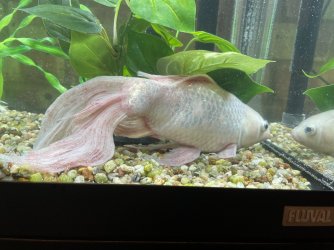Sorry not tropical but couldn’t work out where to post.
I have a very ill samsara comet. I treated him for fin rot (NT Labs then Waterlife - used carbon in between meds for 24 hours). Just finished day 6 of Waterlife White Spot treatment, and I even bought him a bigger 240 litre tank and transferred him to that tonight.
He is still not better and not sure what to do. He swam around a bit and then went back to sitting at the bottom of the tank. He hasn’t eaten for a few days and as you can see his fins are red and rotting.
What temperature should I have the water at - it is currently 23 and I have another shubunkin in there with him. Should I do more White Spot treatment (they seem to have turned red now - not sure what that means) or try the Fin Rot treatment again?
He is over 12 years old and part of the family! I feel like I should have spotted the issues earlier but I was dealing with his friend who recently died of swim bladder
I have tested the water a few times and parameters are all okay.
I have a very ill samsara comet. I treated him for fin rot (NT Labs then Waterlife - used carbon in between meds for 24 hours). Just finished day 6 of Waterlife White Spot treatment, and I even bought him a bigger 240 litre tank and transferred him to that tonight.
He is still not better and not sure what to do. He swam around a bit and then went back to sitting at the bottom of the tank. He hasn’t eaten for a few days and as you can see his fins are red and rotting.
What temperature should I have the water at - it is currently 23 and I have another shubunkin in there with him. Should I do more White Spot treatment (they seem to have turned red now - not sure what that means) or try the Fin Rot treatment again?
He is over 12 years old and part of the family! I feel like I should have spotted the issues earlier but I was dealing with his friend who recently died of swim bladder

I have tested the water a few times and parameters are all okay.


